EcoSport SES ‘deja vu’ is not entirely the same
By John Gilbert
Sports is guilty of beating a good phrase into being trite, such as with the great line, “deja vu all over again,” which Yogi Berra once said, but now is used so regularly by baseball broadcasters that it’s doubtful they even realize that it’s redundant. Ironically, it might apply here, this week.
If this review seems redundant, maybe it’s because you just read about the Ford EcoSport about three months ago, but the deja vu is not happening all over again.
I got to test an EcoSport Titanium with front-wheel drive back in April, and now I’ve recently gotten an EcoSport SES with 4-wheel drive. But there is a lot more than just the engine and trim to differentiate the two, so it’s not really a repeat performance.
For this one, I asked my wife, Joan, to take a drive in it just for here always-sought impressions, and she wasn’t kind. “It’s a dog,” said Joan. I suggested she should give it another try, and use the steering-wheels to paddle-shift the 6-speed automatic, while stomping harder on the gas.
She did, and afterward she said: “Still a dog.”
Talk about redundant. I must allow for her to be right, though, and maybe I give small engines the benefit of the doubt for being able to keep up with larger ones in traffic, and overlook such chinks in pedigree. Maybe some of both.
The EcoSport Titanium we drove in April got mixed impressions, but for good reason. As Ford’s smallest utility vehicle, it had surprisingly good acceleration with only a tiny 1.0-liter 3-cylinder engine, thanks to the EcoBoost turbocharger. But, tiny or not, that engine only comes with front-wheel drive, so it seemed silly up in the North Woods when a late snowstorm accentuated that it was front-wheel drive only — no 4×4.
But now we’ve gotten through July, and the last trace of snow is long gone, fried out of our memory by our foray into what we might call Global Warming Sunstroke Season — 90-degree heat in Minnesota — and the EcoSport SES that arrived as a follow-up came with 4-wheel drive. Go figure. I heard a report from Minneapolis, 2 hours south of Duluth, that through July, they had recorded 17 days of 90 or over, usually a rarity.
The EcoSport SES with 4WD costs only a thousand more, at $25,325, than the fancier Titanium 3-cylinder with FWD, which lists for $24,380. But you lose the conversation-piece of the 3-cylinder 1.0, for the more commonplace 2.0, although with the turbo to handle the extra duty of making all four wheels churn.
An interesting aside: The 2.0 turbo’s 160 horsepower leaves behind the 1.0’s little-impact 123 horsepower, but when it comes to torque, the 2.0 has 146 foot-pounds and the little 1.0 a surprising 148 foot-pounds!
Not that the numbers matter. Of more significance is how it feels, which is where Joan’s assessment might sting. The EcoSport looks to me like a subcompact sedan, but it is classified as an SUV, or more accurately a CUV (crossover utility vehicle). So if you’re going to make and sell me an SUV or CUV in Duluth, Minnesota, make sure it’s a 4-wheel-drive model, OK?
Granted, a good FWD vehicle with the best winter tires (Nokian, anyone?) can go anywhere in any blizzard, but all things equal, you get more efficient blizzard-beating with 4WD or AWD, or whatever you choose to call it on any particular vehicle. To say nothing of the peace of mind feeling that comes along when a blizzard hits and you know you can barge through it.
Frankly, I do appreciate the EcoSport’s utility. It has surprising room for something that looks so stubby — aerodynamic, yes, but still stubby — to have so much available room to haul a couple other adults in the rear seat and to stow groceries or luggage in the way-back, inside the hatch.
Ah, the hatch. When is a hatch not a hatchback? When it’s an EcoSport SES with a side-opening rear door. Maybe Ford wanted to cater to the reputation of U.S. buyers to not want a hatchback, but this one is hinged on the left side, with the door handle on the right, and then look out, because you have to step back to avoid the wide-swinging door.
As a comparatively tall vehicle, there is plenty of headroom, even with the large sunroof, and the stowage might be misleading if they count cubic feet all the way to that high ceiling. There also is plenty of room for housing all the latest connectivity SYNC features, and safety stuff to alert you to blind-spot intruders and to help avoid backing into cross-traffic.
I was disappointed with the fuel economy, which is estimated at 14 city and 36 highway, but I found it unlikely to get it up to 30 in my driving. I also didn’t find the little 3-cylinder approached its EPA estimates, and getting a mini-sized SUV with a tiny engine should at least assure you of lofty mileage.
The sport-tuned suspension in the SES version of the EcoSport does make it handle in a nice, flat, firm attitude around curves or tight corners, and the larger 2.0 4-cylinder has a chance to shine. But you’d be wise to hit the left paddle a couple times and drop down to third or even second if you want anything resembling spunk to be delivered from your little gem.
If you don’t, you won’t have anything at all to stand on as evidence to debate your wife when she suggests the vehicle should be required to wear a collar with a name-tag.


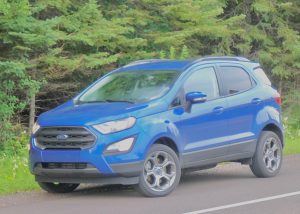
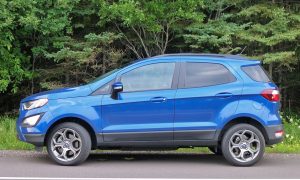
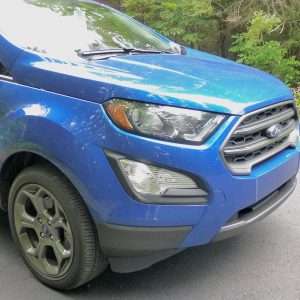
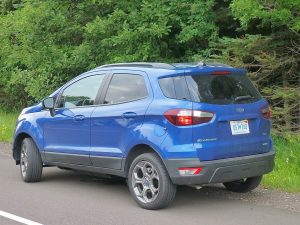
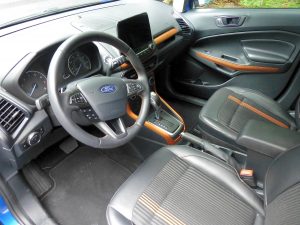
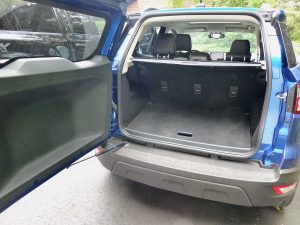
 John Gilbert is a lifetime Minnesotan and career journalist, specializing in cars and sports during and since spending 30 years at the Minneapolis Tribune, now the Star Tribune. More recently, he has continued translating the high-tech world of autos and sharing his passionate insights as a freelance writer/photographer/broadcaster. A member of the prestigious North American Car and Truck of the Year jury since 1993. John can be heard Monday-Friday from 9-11am on 610 KDAL(www.kdal610.com) on the "John Gilbert Show," and writes a column in the Duluth Reader.
John Gilbert is a lifetime Minnesotan and career journalist, specializing in cars and sports during and since spending 30 years at the Minneapolis Tribune, now the Star Tribune. More recently, he has continued translating the high-tech world of autos and sharing his passionate insights as a freelance writer/photographer/broadcaster. A member of the prestigious North American Car and Truck of the Year jury since 1993. John can be heard Monday-Friday from 9-11am on 610 KDAL(www.kdal610.com) on the "John Gilbert Show," and writes a column in the Duluth Reader.